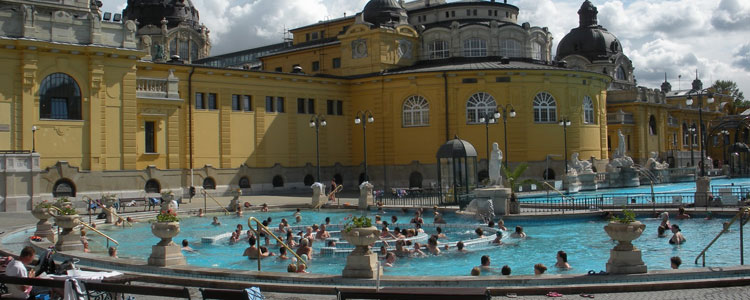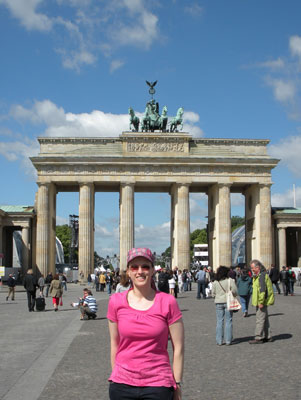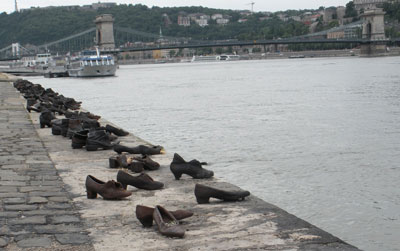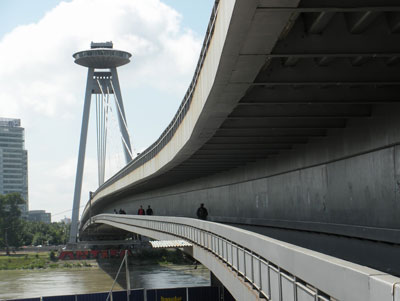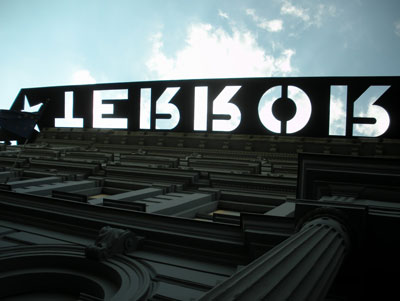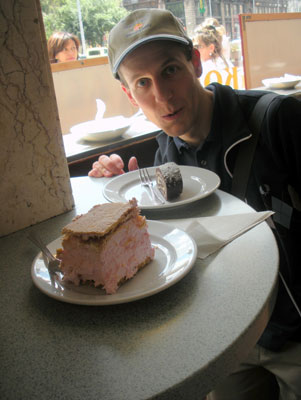Finding reminders of royalty, World War II and the Communist era on a five-country tour
by Jennifer Petoff; San Francisco, CA
My husband, Scott, and I spent two weeks in Central Europe in May ’09 and were impressed by the richness of political history that we encountered on our journey. We visited Berlin, Prague, Budapest, Vienna and Bratislava, each destination offering a window into the opulent lifestyles of kings and queens, the tragedy of World War II and the austerity of the Communist era.
Beginning in Berlin
We confronted the consequences of World War II almost immediately upon landing in Berlin. We took a taxi from the Berlin Tegel Airport to Hotel Otto (phone +49 30 54 71 00 80, www.hotelotto.com — €83, or $111, per night) in the Charlottenburg neighborhood. From there we took a walk through the area, passing the famous bombed church of Berlin, Kaiser-Wilhelm-Gedächtniskirche. The church was partially destroyed during World War II, and the ruins remain as a memorial and reminder of that dark time.
In the morning, rested and ready to explore, we took the local S-Bahn (train) from Zoologischer Garten to Friedrichstraße Station, the first stop for the subways in East Berlin during the Cold War. At that time, the station was utilized by two West Berlin S-Bahn lines and the U-Bahn’s U6 line, and it served as the lone transfer point for Westerners within East Berlin.
From Friedrichstraße Station we walked to the head of Unter den Linden to check out the Brandenburg Gate.
Humboldt University, the oldest university in Berlin, was the next stop on our walk. Founded in 1810, the university has matriculated a number of prominent students, including Albert Einstein.
Outside the university, vendors set up shop along Unter den Linden to sell books, which seemed particularly symbolic given that, on May 10, 1933, the Nazi Party burned almost 20,000 books in the plaza across the street. Thankfully, times have changed.
Memories of war
We spent the afternoon trekking around Berlin on the three-hour Third Reich walking tour (€12, or $16) with Original Berlin Walks (phone +49 30 301 9194, www.berlinwalks.com). In the US, the cautionary tale of Nazi history is covered with the detachment of distance, so this was an amazing opportunity to get some firsthand perspective.
Edo, a history student from the Netherlands, led our tour. We took the train from Zoologischer Garten Station to Mohrenstraße Station, which features extravagant red marble that purportedly was salvaged from Hitler’s Reich Chancellery. The tour pointed out some typical Nazi-era architecture as well as some of the buildings that evolved from there. (For example, Hitler’s Reich Chancellery is now a Chinese restaurant.)
The tour ended at the location of the bunker where Hitler ultimately committed suicide. The site is now a parking lot. A sign marking the spot was put there only recently. Edo pointed out how the Germans are still grappling with this difficult part of their past and had been reluctant to memorialize the Nazi era in any way. After the tour ended, we continued down the street to pay our respects at the Memorial to the Murdered Jews of Europe.
On another day we took the train to Ostbahnhof to see the East Side Gallery, a section of the Berlin Wall more than one kilometer long that has been painted by a variety of renowned artists as a memorial to freedom.
At the Mauer Museum at Checkpoint Charlie (Friedrichstraße 43-45; www.mauer-museum.com — €12.50), heroic tales of ingenuity in escaping Communist oppression were on display. From creating complicated pulley assemblies to doubling over in specialized luggage, people went to great lengths to escape the Deutsche Demokratische Republik (DDR). Heart-wrenching stories of mothers separated from their children, families torn apart and casualties of oppression are remembered here.
On to Prague
From the Hauptbahnhof in Berlin, we traveled on Deutsche Bahn to Prague Holsevice Station in about four hours (€104 per person). The first thing I noticed about Prague was the speed of its escalators. We hopped on and held on tight as we made our way out of the station and onto the tram system.
We took the tram to Hotel Elite (phone +420 224 932 250, www.hotelelite.cz), where our room cost €198 ($265) for two nights. It was near hlavní nádraží Station, in a bustling area near the border between the old (Staré Meˇsto) and new (Nové Meˇsto) sections of Prague.
We walked from the hotel to the Old Town Square, where tourists flock to watch the clock performance every hour. From there we headed to Karlu˚v most (Charles Bridge), which spans the Vltava River. Dating from the 14th century, the bridge features spectacular statues of religious figures along its length.
We went to dinner at Restaurace U Fleků, Prague’s oldest brewery. They still brew their own beer, and two frosty mugs were slapped on the table as soon as we sat down, before our order was taken.
Musicians roamed the dining area, pandering to the tourists in the house. After asking where we were from, they played “When the Saints Go Marching In” and “America the Beautiful,” then moved on to the next table, whose patrons were from Japan, then to a table full of Italians. It was all in good fun, but, I must say, the last thing I want to do when I’m in Prague’s oldest brewery is listen to American, Japanese or Italian songs.
The waiter was peddling shots of Becherovka, a traditional Czech liquor. This was capitalism on full display. I resisted the first two times that he walked by, but when the group of Japanese tourists each decided to down a shot, I couldn’t resist and tried it out. It was very herby, with hints of clove and nutmeg.
Historical sites
We decided to take a Prague guided walk (CZK300, or $16) through the former Jewish Ghetto on our last day in town. Roman Bily (look for him near the Old Town Hall) led the group from Old Town Square into the Jewish Quarter. Roman was incredibly knowledgeable and shared a lot of medieval and recent history.
The cemetery in the former Jewish Ghetto was especially impressive. Beginning in 1439 and continuing over the next 350 years, the residents crammed nearly 100,000 bodies into a one-kilometer-by-one-kilometer space, the bodies buried up to 12 layers deep!
We also visited the Old New Synagogue, the oldest synagogue in Europe that is still in use.
We spent our remaining hours in Prague at the Museum of Communism (Na Prikope 10, www.muzeumkomunismu.cz — CZK180, or $9.50), where we saw a video on the Velvet Revolution, when, in 1989, thousands of citizens lined Wenceslas Square to demand change — a peaceful end to the Communist era.
Impressions of Budapest
At Prague’s central station we boarded an overnight train bound for Budapest’s impressive and ornate Keleti Station. We booked our tickets through Rail Europe (www.raileurope.com); they cost $353 for a first-class double sleeper.
Our arrival in Hungary marked the beginning of a new phase of our vacation: the dessert phase. Both Budapest and Vienna, where we would end our tour, are known for their cakes and pastries, and we were excited to start sampling.
We took the subway from Budapest’s Keleti Station to Opera Station and checked in at K+K Hotel Opera (phone +36 1 269 02 22, www.kkhotels.com/opera) at E240 for two nights with breakfast. We dropped off our bags, then walked down Andrássy út. After a few wrong turns, we found our way to Café Gerbaud, where we sampled a variety of treats.
Sweet tooth sated, we walked along the river to the Chain Bridge, which connects Buda with Pest. The bridge was destroyed in World War II but was rebuilt to its former glory in 1949.
Continuing along the waterfront, we passed 60 pairs of bronze shoes — a memorial for local holocaust victims. Near the end of the war, soldiers would sometimes line up Jews along the water’s edge, tether several people together and then, to conserve bullets, shoot just one person. The rest, sadly, were destined to drown. This was definitely a sobering memorial.
Also along the waterfront, the Hungarian Parliament building is an amazingly impressive piece of architecture. Currently, only about one-eighth of the building is used for government business.
The House of Terror (Andrássy út 60, www.terrorhaza.hu), located in the former headquarters of the secret police — a building where political dissidents were tortured and killed throughout the 20th century — was the single most sobering and moving museum that we visited on our trip.
Upon paying admission (HUF1,800, or $9) and entering the museum, we were immediately faced with a giant tank. The exhibits simply overwhelmed the senses.
The first room was particularly memorable. On one side, videos of World War II and the advance of the Nazis played while, on the other side, Stalin and the Soviet armies showcased the invasion of Communism into the region. While the videos cycled, thumping, industrial-style music played in the background.
The museum featured many videos of individuals telling their stories of suffering in the gulags. A room full of Communist propaganda lightened the mood (slightly) before we descended into a block of torture chambers.
Despite its grave subject matter, I highly recommend this museum. We learned so much about the history of both World War II and the Communist era in the region.
We considered several choices for dinner but ultimately decided to take advantage of the lovely evening and dine outdoors at Menza (phone +36 1413 1482), located on Liszt Ferenc Square. The restaurant was completely modern and chic but was designed to invoke memories of Communist-era cafeterias.
I started my meal with cold, sour cherry soup, then had goulash with homemade spinach dumplings — delicious! With a bottle of Hungarian wine, our meal cost about $20 per person.
Sampling local products
We started out bright and early the next morning and took the subway to Budapest’s Great Market Hall. The market featured purveyors of paprika, both hot and sweet, everywhere we looked plus stalls that were simply overflowing with produce. I can just imagine what a stark contrast this must be from the days of Communism, when fresh goods were expensive and hard to come by.
We couldn’t resist when we saw a vendor selling about 15 different kinds of strudel. We opted for the cherry-plum.
The entire second floor of the market featured craft and souvenir vendors.
We felt a special connection to Hungarian poet and revolutionary Sándor Petöfi because of our similar names. Crossing onto Petöfi Sándor utca after leaving the Great Market Hall and browsing our way along Váci utca, we stopped for a treat at a Communist-era stand-up café at the head of the street.
It was an adventure for us to figure out the process of ordering and paying, especially since we don’t speak Hungarian. After observing for a few minutes, we realized that we needed to specify what we wanted, pay the cashier, then go back to the bakery counter to pick up our items.
Each item was labeled, but Hungarian is super-difficult to pronounce. Ultimately, we wrote down the names of the items we wanted on a scrap of paper and showed them to the cashier. Triumph!
Time for a soak
We decided to indulge in a true local pastime, so we headed to the Szechenyi baths (HUF2,500, or $12.50), located in the city park, not far from the zoo. Guests pay for three hours of access to pools of varying temperatures, including both “relaxing” and “fun” pools. We rented a private changing room, donned our suits and jumped right in.
What do I remember most about the experience? I remember portly older gentlemen strutting around in Speedos. Many were huddled in the water next to chessboards, contemplating their next moves.
The “fun” pool was particularly enjoyable. We discovered that the center spiral featured a strong current that whisked bathers around in a circle. ’Round and ’round we went, giggling all the way. The current was pretty rough, and Scott and I actually got slightly banged up during the fun.
When we moved to calmer waters, I realized that my earlobe was scratched and had started to bleed. (It’s all fun until someone gets hurt!) I quickly left the pool to tend to my ear, then we spent the rest of our time in the warmer, calmer relaxation pool.
If you leave before your three hours are up, at the exit you are directed to the cashier for a refund on the unused portion of your admission. This seems to be another artifact from the Communist era. The public baths were one constant during years of war and political turmoil in the region.
Next stop: Vienna
We arrived in Vienna and, as we had done in Budapest, took a tour of the Opera House (www.staatsoper.at), for E5 each. Drawing a baseball analogy, the Budapest Opera is like the AA farm team whereas the Vienna State Opera is the Big Leagues.
The Vienna Opera puts on 150 performances a year. Every day, up to 30 truckloads of sets, props and costumes arrive from a warehouse nearby.
The 2008-2009 season featured about 60 different shows. Each show is performed once, so the sets are changed out daily. The amount of sweat and effort required to keep the opera up and running is simply amazing.
We had a rare opportunity to go backstage, where the staff was setting up for the evening’s performance of “Romeo and Juliet.” We also were able to take a seat in front of the stage, relishing our surroundings. It was fun to revel in the richness of the concert hall and reflect on how Emperor Franz Josef and his beloved wife, Sisi, had once applauded performances from their private box.
After steeping in the grandeur of the Vienna State Opera, we took a moment to reflect on and admire the sculptures at the nearby Monument Against War and Fascism — another sobering reminder of the devastation that invaded the region in the last century.
Day trip to Bratislava
The next day, we learned, was a religious holiday in Vienna and we were disappointed that many things in the city would be closed as a result. However, we discovered that there was a significant contrast between countries that were once behind the Iron Curtain and those that were not. It was not a holiday in Slovakia, so, since Bratislava is a mere hour from Vienna, we hopped on the early train (E14 per person) to check it out.
From Bratislava’s bustling train station, we walked down a busy road to the pedestrian-only Old Town, passing a number of interesting sights, including the Imperial Palace. Strolling around the Old Town, we spotted a number of the eclectic statues that are well known throughout the city.
We walked out onto the Apollo Bridge (noted for the UFO-shaped restaurant located there) that spans the Danube. This Communist-era relic is controversial among the locals. For us, it was another quirky and enjoyable sight.
One final day
Despite the holiday, some popular attractions in Vienna were open. Upon returning to the city, we took the local S- and U-Bahn lines out to Schloss Schönbrunn (www.schoenbrunn.at), home to centuries of Austrian royalty.
After touring the interior of the palace and the gorgeous grounds (E9.50 for the “Imperial Tour”), Scott and I climbed the hill to the Gloriette to enjoy panoramic views of the city. We also tried out the hedge maze on the premises.
We capped our final evening in Vienna with a mini Sacher-Torte, which we purchased directly from Hotel Sacher, combined with a glass of 89-euro-cent Zweigelt wine from the supermarket, reflecting on an amazing trip to Central Europe that was filled with sights and tales of royalty, World War II and the Communist era.
We now have a much greater understanding of the events and politics that shaped this region, and our vacation was far more educational than we ever could have anticipated.

